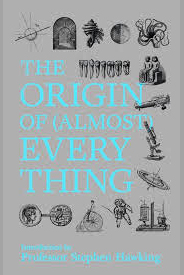
The Origin of Almost Everything
By Graham Lawton and Stephen HawkingIntroduction by Stephen Hawking
Compiled by New Scientist
Published in Great Britain by John Murray and in USA by Nicholas Brealey Publishing
This is an amazing book on origins of all kinds of things. And the only qualification required for browsing through the book which deals with many things under the sun is curiosity. The reader would be immensely rewarded by spending time here. The subject matter of the book is broadly divided under 6 major sub headings: The Universe, Our Planet, Life, Civilization, Knowledge and Inventions.
The complex topic of the origin of the universe is dealt with in an easily understandable manner. The Bing Bang is the mainstream explanation for the origin of the universe, but it doesn’t have the floor to itself... Another is that the big bang was one of the many. According to multiverse theory, our universe is just one bubble in a seething froth of universes.
In the chapter on Life, we have a fascinating account of When Did Life Begin? A short answer: four billions years ago! One theory says that life came to earth from outer space.
Another topic dealt with is Why Do We Sleep? Sleep is not just one thing but two. The first is called deep or slow wave sleep. The second is rapid eye movement sleep (REM). A human being need both kind of sleep for good health. We dream during the REM sleep. If sleep is mentioned, can dreams be far away? It is widely accepted that dreams can be influenced by waking experiences.
There is an interesting discussion on How Did Apes Become Human? Homo Sapiens is what we are and we are on planet earth for the last 7 million years or so. Sharing space with other living things.
There is an interesting item on How Did We Discover Nothing. It is about the invention of the concept of the zero in India 14 centuries ago. The first record we have of the number zero appears in a squashed egg symbol recognizable close to our own, in an inscription at a temple in Gwalior, Northern India.
The book contains innumerable interesting titbits on physical things as well as conceptual ideas of interest to the curious reader, who can delve into this treasure of a book at random, to keep himself/herself informed of many useful things in an easy to understand manner.

